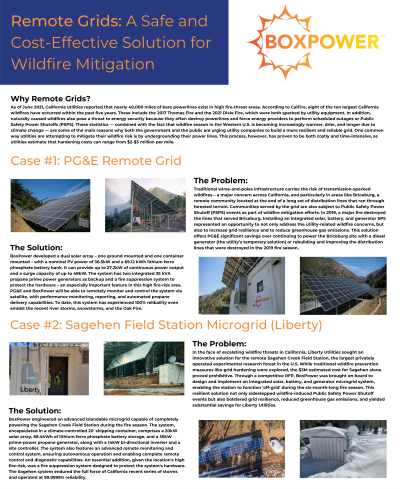Back

Grid Integration
Remote Grids: A Safe and Cost-Effective Solution for Wildfire Mitigation
Tuesday, September 12, 2023
4:30 PM - 5:30 PM PDT
Location: Poster Area, Booth #11024, Level 1, Venetian Expo Hall


Noa Schachtel, n/a
Marketing Coordinator
BoxPower
GRASS VALLEY, California, United States
Poster Presenter(s)
Background, Description, Delivery and Learning Objective As of June 2021, California utilities reported that nearly 40,000 miles of bare powerlines exist in high fire-threat areas. According to CalFire, eight of the ten largest California wildfires have occurred within the past five years. These include the 2017 Thomas Fire and the 2021 Dixie Fire, which were both sparked by utility equipment. In addition, naturally caused wildfires also pose a threat to energy security because they often destroy powerlines and force energy providers to perform scheduled outages or Public Safety Power Shutoffs (PSPS). These statistics — combined with the fact that wildfire season in the Western U.S. is becoming increasingly warmer, drier, and longer due to climate change — are some of the main reasons why both the government and the public are urging utility companies to build a more resilient and reliable grid. One common way utilities are attempting to mitigate their wildfire risk is by undergrounding their power lines. This process, however, has proven to be both costly and time-intensive, as utilities estimate that hardening costs can range from $3-$5 million per mile.
In this session, BoxPower’s CFO and co-founder Anderson Barkow will be discussing two case studies, namely the Sagehen Field Station Remote Grid contracted by Liberty Utilities and the Briceburg Remote Grid contracted by PG&E, to show how standalone power systems helped these IOUs reduce cost and wildfire risk. He will also discuss how Liberty, PG&E, SCE and other utilities throughout the west are using the same approach at a portfolio level for aging infrastructure in need of upgrade or replacement. These projects serve as just two examples as to how energy providers can leverage solar microgrids in remote regions to save money, mitigate the risk of disaster, and meet their net-zero targets.
In this session, BoxPower’s CFO and co-founder Anderson Barkow will be discussing two case studies, namely the Sagehen Field Station Remote Grid contracted by Liberty Utilities and the Briceburg Remote Grid contracted by PG&E, to show how standalone power systems helped these IOUs reduce cost and wildfire risk. He will also discuss how Liberty, PG&E, SCE and other utilities throughout the west are using the same approach at a portfolio level for aging infrastructure in need of upgrade or replacement. These projects serve as just two examples as to how energy providers can leverage solar microgrids in remote regions to save money, mitigate the risk of disaster, and meet their net-zero targets.
